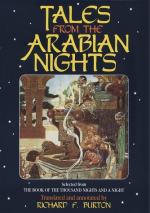[FN#327] The origin of the lens and its applied use to the telescope and the microscope are “lost” (as the Castle-guides of Edinburgh say) “in the glooms of antiquity.” Well ground glasses have been discovered amongst the finds of Egypt and Assyria: indeed much of the finer work of the primeval artists could not have been done without such aid. In Europe the “spy-glass” appears first in the Opus Majus of the learned Roger Bacon (circa A. D. 1270); and his “optic tube” (whence his saying “all things are known by perspective"), chiefly contributed to make his wide-spread fame as a wizard. The telescope was popularised by Galileo who (as mostly happens) carried off and still keeps, amongst the vulgar, all the honours of invention. Some “Illustrators” of The Nights confound this “Nazzarah,” the Pers. “Dur-bin,” or far-seer, with the “Magic Mirror,” a speculum which according to Gower was set up in Rome by Virgilius the Magician hence the Mirror of Glass in the Squire’s tale; Merlin’s glassie Mirror of Spenser (F. Q. ii. 24); the mirror in the head of the monstrous fowl which forecast the Spanish invasion to the Mexicans; the glass which in the hands of Cornelius Agrippa (A. D. 1520) showed to the Earl of Surrey fair Geraldine “sick in her bed;” to the globe of glass in The Lusiads; Dr. Dee’s show-stone, a bit of cannel-coal; and lastly the zinc and copper disk of the absurdly called “electro-biologist.” I have noticed this matter at some length in various places.
[FN#328] D’Herbelot renders Soghd Samarkand = plain of Samarkand. Hence the old “Sogdiana,” the famed and classical capital of Mawarannahr, our modern Transoxiana, now known as Samarkand. The Hindi translator has turned “Soghd” into “Sada” and gravely notes that “the village appertained to Arabia.” He possibly had a dim remembrance of the popular legend which derives “Samarkand” from Shamir or Samar bin Afrikus, the Tobba King of Al-Yaman, who lay waste Soghd-city ("Shamir kand” = Shamir destroyed); and when rebuilt the place was called by the Arab. corruption Samarkand. See Ibn Khallikan ii. 480. Ibn Haukal (Kitab al Mamalik wa al-Masalik = Book of Realms and Routes), whose Oriental Geography (xth century) was translated by Sir W. Ouseley (London, Oriental Press, 1800), followed by Abu ’l-Fida, mentions the Himyaritic inscription upon an iron plate over the Kash portal of Samarkand (Appendix No. iii.).
[FN#329] The wish might have been highly indiscreet and have exposed the wisher to the resentment of the two other brothers. In parts of Europe it is still the belief of the vulgar that men who use telescopes can see even with the naked eye objects which are better kept hidden; and I have heard of troubles in the South of France because the villagers would not suffer the secret charms of their women to become as it were the public property of the lighthouse employes.
[FN#330] “Jam-i-Jamshid” is a well worn commonplace in Moslem folk-lore; but commentators cannnot agree whether “Jam” be = a mirror or a cup. In the latter sense it would represent the Cyathomantic cup of the Patriarch Joseph and the symbolic bowl of Nestor. Jamshid may be translated either Jam the Bright or the Cup of the Sun: this ancient King is Solomon of the grand old Guebres.




